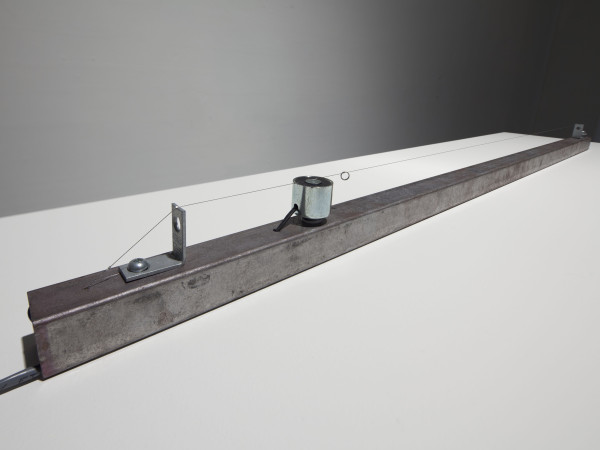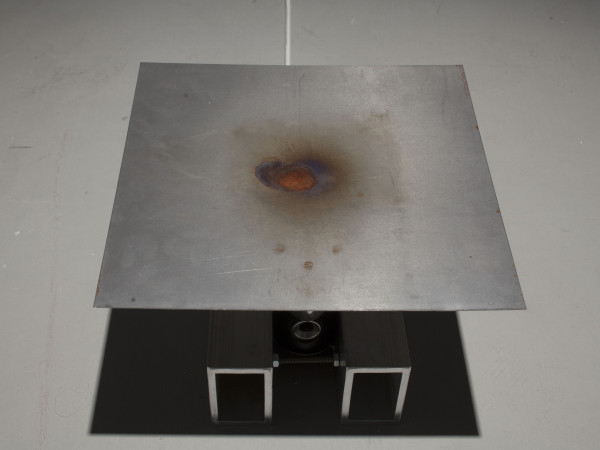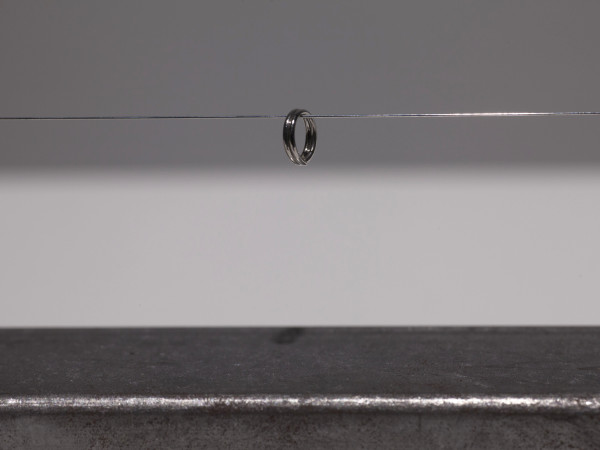In the spring of 2013, LA CHAMBRE BLANCHE invited So Kanno for a residency. A native of Tokyo, the artist is accustomed to producing “eye-catching” works that represent his boisterous, animated city. Confronted with a quiet place, and with the perspective of research more than production, the Japanese artist chose to be concerned with the minuscule, paying attention to the almost imperceptible noise of his daily life. In the exhibition Objects of Sound, he invited us to give our full attention to sound as a phenomenon in four different installation works. In this respect, the exhibition title is enigmatic: is it the object that produces sound or is it sound that is considered the object?
During his residency, So Kanno endeavoured to explore the sounds that emanate from the most ordinary small objects. The components, the majority being of metal––a stainless steel bowl, an iron, a guitar string, ball bearings––were used to construct his installations. From these found objects, he discovered corresponding sounds: “I got the idea when my sink got blocked and the dishes floated in my washbasin. The sound was marvellous,” the artist explained. With his knowledge of robotics, So Kanno attempted to reproduce the everyday sounds mechanically, the drops of falling water, the hum of the refrigerator, and so on. The unobtrusive events of reality thus became the material of his works.
The formal simplicity of the installations is in keeping with the commonplace nature of the components, and thus makes the works’ visual appearance fade in front of the sound aspect. Being hardly audible, the sounds require all the viewer’s attention. The effectiveness of this minimalist aesthetics lets one appreciate the poetry of the mechanics. In turn, the installations emit either a hum, in which the viewer can hear the variations, or a regular pulsation. The sounds follow a recursive and organized structure, completely controlled by a kinetic system. The movements that provoke them however are almost imperceptible: the guitar string hardly vibrates, the ball bearings and the drops of water that fall on the ground are not seen, while the sound in the stainless steel bowl is produced by its magnetic field. So Kanno therefore has looked for the minimum threshold for perceiving the slightest movement. Only the sound indicates an impulse.
The sounds thus created invite the viewer to a sensory experience. Whether this involves a continuous or repetitive form, the passing of time seems to stop. The high or low tonality, the duration and the resonance in the space transform and activate the spatial-temporal experience. Exploring the various physical qualities of the noise heard then leads to an architectural sound construction. The sound is integrated into a broader definition of sculpture: as sculptural material, it is an immaterial object that can be shaped, manipulated and organized in time and space.
However, this structuring of sound as material does not lead to the elaboration of a musical discourse. If there is a sound narrative, it appears only through reference to the objects, to the visual elements in the installation. This is why So Kanno has chosen not to use an electroacoustic system, but rather to present objects that are visually capable of backing up what one is hearing. The sounds are looked at and not only listened to. The steam that comes from each drop that falls and the progressive oxidation of the steel plate emphasizes the importance given to the visual aspect. This steam is associated with that of the iron, an everyday object integrated into the installation moreover.
In renouncing the microphone, the sound is created in the place itself and in the present moment. The works are completely independent, created on the basis of a simple mechanic borrowed from that of the loudspeaker. In fact, the installations work with magnets that serve, for example, to make the guitar string vibrate or to operate a metal rod in the magnetic field of the bowl. Resonating easily due to the acoustics of the space, each sound carries a poetic charge: they evoke the sacred sound of the gong and the pulsations of nature. The works in Objects of Sound thus operate according to an enclosed, independent mechanism, as artificial creatures would. By multiplying the sensorial aspect, they enable one to live and hear the reality in what is fundamentally experimental. So Kanno builds a bridge between the orderly motifs of our everyday machines and the mysterious energies of the universe.




